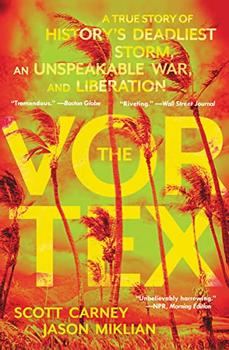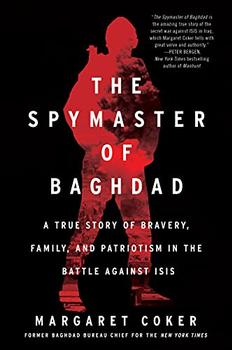Summary | Excerpt | Reviews | Beyond the book | Read-Alikes | Genres & Themes | Author Bio

A True Story of History's Deadliest Storm, an Unspeakable War, and Liberation
by Scott Carney , Jason MiklianIn November 1970, a massive cyclone blew up from the Bay of Bengal and made landfall along the densely populated coastline of what was then East Pakistan, now Bangladesh. The tiny islands of Bhola and Manpura were hardest hit, but the former lent this storm its name: the Great Bhola Cyclone. It would kill roughly 500,000 people and devastate the lives of countless more Pakistani Bengalis. But it was also the catalyst for a tidal wave of violence that would split one nation apart, spur the creation of a new one and bring the world to the doorstep of nuclear confrontation (once again).
In The Vortex: A True Story of History's Deadliest Storm, an Unspeakable War, and Liberation, Scott Carney and Jason Miklian achieve a miracle of sorts in weaving three overarching stories into a convincing, satisfying whole. A work of narrative nonfiction, the story unfolds through the eyes of its key players, including Pakistan's notorious president, General Yahya Khan; American expatriates and activists Jon and Candy Rohde; a soccer player turned soldier, Hafiz Uddin Ahmad; and cyclone survivor and budding Bengali revolutionary, Mohammed Hai. Making infamous appearances, as well, are American president Richard Nixon and his wily Secretary of State, Henry Kissinger, who seek Khan's help in brokering a historic meeting between the U.S. and China. All represent the different faces of the cyclone response and West Pakistan's secret war against East Pakistan targeting the nascent Bengali independence movement.
The partition of India in 1947 created West Pakistan and East Pakistan, two noncontiguous territories separated not only physically by India, Pakistan's nemesis, but also by deep cultural, ethnic and religious differences. At the time of the Great Bhola Cyclone of November 1970 (see Beyond the Book), President Khan's sole focus was ensuring Pakistan's first National Assembly general election since gaining independence from India went off without a hitch, thereby securing his legacy as "Pakistan's Father of Democracy." While boozing it up during his off (and on) hours, he curried his curious friendship with President Nixon, negotiating for a steady stream of weapons and aid packages to bolster their important Cold War alliance against the Soviet Union. In return, Nixon asked Khan to initiate backchannel communications with China, signaling American interest in reestablishing harmonious relations after 25 years of diplomatic isolation. This Khan did to the exclusion of all else, including the horrific suffering in the aftermath of the monster cyclone that slammed into East Pakistan's coastline on November 12, 1970.
To emphasize the level of disconnection felt between West and East Pakistan, Carney and Miklian eloquently describe the situation before the natural disaster: "West Pakistan and East Pakistan had been locked in a kind of cold war within a Cold War for the last twenty years," divided geographically and culturally. The West held more political and economic power, with its residents speaking mostly Urdu and Punjabi. East Pakistan was poorer, more populous, and possessed far less political power. Residents spoke Bengali. As the monster storm shrieked across the grass-thatched huts on the islands, these differences became more painful when President Khan dismissed the gravity of East Pakistan's suffering in a flyover, commenting to the pilot, "It doesn't look so bad."
In a series of alternating chapters, the authors shuffle viewpoints that tie the natural disaster and its political fallout into an understandable milieu for the general reader. Among the powerful scenes featuring those directly involved is Mohammed Hai's chilling ordeal surviving the storm by clinging to a palm tree for hours, and the neverending horror of burying thousands of corpses for weeks while waiting for food, water and medical assistance from the central Pakistani government that never came. Providing a hopeful glint of humanity in a story rife with corruption, greed and governance-gone-wrong is the selfless service of Jon and Candy Rohde, an American doctor-teacher husband-and-wife team who organized successful grassroots efforts to send vital food and medical supplies to the islands. They would soon witness a second, human-made storm as East Pakistan elected its autonomy-leaning party candidates overwhelmingly to the National Assembly in December 1970, threatening West Pakistan's control over the Bengali region in the east.
What followed was a brutal crackdown and disavowal of the election results, as Khan unleashed his military on the Bengali population of Dacca (now Dhaka, the capital of Bangladesh). He received Nixon's illegal under-the-table weapons shipments meant to maintain a single Pakistan friendly to the U.S. (and prohibit East Pakistan from becoming an independent Bangladesh more friendly toward the Soviet Union and India). However, Khan overplayed his hand by attacking India for its support of Bangladeshi revolutionaries, provoking its neighbor into the third war since the partition. Carney and Miklian expertly ratchet up the tension in scenes reminiscent of thriller novels as the American U.S.S. Enterprise aircraft carrier pushes into the Bay of Bengal and the Soviet Navy rushes to meet them, nuclear launch orders imminent. The brief war eventually brought the central Pakistani government to the negotiating table, triggering East Pakistan's transformation into the sovereign Bengali nation of Bangladesh on March 26, 1971.
Mining more than 750 official documents and sources, as well as conducting more than 200 interviews, Carney and Miklian reveal the appalling lengths Nixon, Kissinger and Khan went to ensure the "CHINESE CONNECTION" (as Khan named his negotiations with Mao) happened. They also elevate the impacts of climate change upon already-fraught geopolitical situations as "disasters are increasingly used to leverage political aims, using the same blueprint that Yahya Khan did after the Great Bhola Cyclone." They warn that these scenarios are "nauseatingly familiar" around the world as local politicians use droughts, tsunamis and other natural disasters to justify or intensify wars, such as the 2017 drought in Sudan, the 2004 Sri Lanka tsunami and the 2016-2020 drought-flood cycles in Afghanistan and Somalia, to name a few.
The Vortex tells just one story (but a whopper of one) in novel-like prose that grips the reader at the same time it educates about cause-and-effect in both the natural world and human societies.
![]() This review was originally published in The BookBrowse Review in April 2022, and has been updated for the
April 2023 edition.
Click here to go to this issue.
This review was originally published in The BookBrowse Review in April 2022, and has been updated for the
April 2023 edition.
Click here to go to this issue.

If you liked The Vortex, try these:

by David Grann
Published 2025
Winner: BookBrowse Nonfiction Award 2023
From the #1 New York Times bestselling author of Killers of the Flower Moon, a page-turning story of shipwreck, survival, and savagery, culminating in a court martial that reveals a shocking truth. The powerful narrative reveals the deeper meaning of the events on The Wager, showing that it was not ...

by Margaret Coker
Published 2022
From the former New York Times bureau chief in Baghdad comes the gripping and heroic story of an elite, top-secret team of unlikely spies who triumphed over ISIS.
Judge a man by his questions rather than by his answers.
Click Here to find out who said this, as well as discovering other famous literary quotes!
Your guide toexceptional books
BookBrowse seeks out and recommends the best in contemporary fiction and nonfiction—books that not only engage and entertain but also deepen our understanding of ourselves and the world around us.